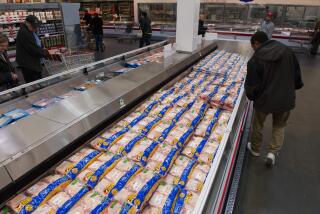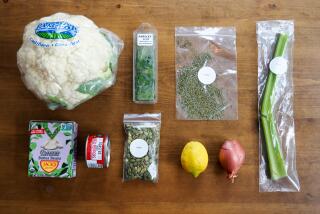TODAY’S TIP : Handling Tips for Chicken
- Share via
Chicken is one of America’s favorite foods. But the raw meat can contain potentially dangerous bacteria. Here are some tips for purchasing, preparing and storing chicken safely:
Purchasing
* Purchase chicken from retailers that keep fresh meats at 40 degrees or lower and frozen meats at 0 degrees or lower.
* Be sure packaging is intact and there is no strange odor or stickiness. Home refrigerators should be set as cold as possible without causing food to freeze, between 34 and 40 degrees.
* Bacteria grow well between 40 degrees and 140 degrees, so keep chicken and other high-risk foods out of this temperature range as much as possible.
* Store wrapped chicken with the date visible on the package in a shallow pan or bowl on the lower shelf of the refrigerator or freezer, away from ready-to-eat foods. This will prevent juice from the chicken from leaking to other parts of the refrigerator, where it can contaminate other foods. Keep chicken refrigerated until immediately before use.
Preparing
* Cook or freeze fresh chicken within one or two days of purchase and cook frozen chicken within a year, noting that quality decreases over time in the freezer.
* Wash hands thoroughly before gathering ingredients and rewash each time hands come into contact with raw meat, meat juices or anything unclean or soiled. Use hot water, moisten hands, lather and rub hands together for at least 20 seconds and rinse thoroughly. When wearing short sleeves, wash exposed parts of the forearm that come into contact with food. Dry with a paper towel or freshly laundered towel used solely to dry your hands one time.
* Cross contamination, the spread of bacteria from one food to another, most commonly occurs when raw meats or meat juices come into contact with hands, other foods, cutting boards, utensils, the sink or counters. Ideally, a separate cutting board should be reserved for meat and another for fresh vegetables.
* Wash, rinse and sanitize cutting boards, dinnerware, plastic, glassware, counter tops, dishcloths and sponges that come into contact with uncooked meat or other potentially harmful foods. Do not simply wipe off with a wet towel or sponge. Change sponges often and let them soak in sanitizing solution two minutes to help prevent bacterial growth.
* Wash items in extremely hot water, scrub with soap and rinse in hot water. To sanitize, submerge in sanitizing solution two minutes or spray the solution on and allow to air-dry.
* Don’t assume the chicken is cooked just because it looks cooked. To kill bacteria, cook the chicken to an internal temperature of 165 degrees or higher for at least 15 seconds and eat within two hours of cooking.
Leftovers
* All prepared foods, whether hot or cold, should be refrigerated or frozen within two hours.
* Do not use utensils that have touched raw meat to pick up cooked meat.
* There are several ways to cool food before refrigeration: place it in a zip bag, then cool it in ice water and move to the refrigerator; cut chicken into small portions or put it in shallow pans, then surround with ice water until cool and refrigerate; cut chicken into small portions and refrigerate loosely covered.
* Store cooked chicken on a top shelf of the refrigerator. Do not combine leftover chicken from one day with leftover chicken from another day. Do not refrigerate prepared food longer than two days.
Source: Times reports.
More to Read
Eat your way across L.A.
Get our weekly Tasting Notes newsletter for reviews, news and more.
You may occasionally receive promotional content from the Los Angeles Times.










